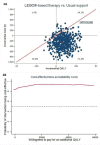Cost-utility analysis of LEGO based therapy for school children and young people with autism spectrum disorder: results from a randomised controlled trial
- PMID: 35039300
- PMCID: PMC8765033
- DOI: 10.1136/bmjopen-2021-056347
Cost-utility analysis of LEGO based therapy for school children and young people with autism spectrum disorder: results from a randomised controlled trial
Abstract
Objectives: To assess the cost-effectiveness of LEGO-based therapy compared with usual support.
Design: Cost-utility analysis alongside randomised control trial.
Setting: Mainstream primary and secondary schools in the UK.
Participants: 248 children and young people (CYP) with autism spectrum disorder (ASD) aged 7-15 years.
Intervention: LEGO-based therapy is a group social skills intervention designed specifically for CYP with ASD. Through play, CYP learn to use the skills such as joint attention, sharing, communication and group problem-solving. CYP randomised to the intervention arm received 12 weekly sessions of LEGO-based therapy and usual support, while CYP allocated to control arm received usual support only.
Main outcome measures: Average costs based on National Health Service (NHS) and personal social services perspective and quality-adjusted life years (QALYs) measured by EQ-5D-Y over time horizon of 1 year were collected during the trial. Incremental cost-effectiveness ratio (ICER) was calculated, and non-parametric bootstrapping was conducted. The uncertainty around the ICER estimates was presented using cost-effectiveness acceptability curve (CEAC). A set of sensitivity analyses were conducted to assess the robustness of the primary findings.
Results: After adjustment and bootstrapping, on average, CYP in LEGO-based therapy group incurred less costs (incremental cost was -£251 (95% CI -£752 to £268)) and gained marginal improvement in QALYs (QALYs gained 0.009 (95% CI -0.008 to 0.028)). The CEAC shows that the probability of LEGO-based therapy being cost-effective was 94% at the willingness-to-pay threshold of £20 000 per QALY gained. Results of sensitivity analyses were consistent with the primary outcomes.
Conclusion: Compared with usual support, LEGO-based therapy produced marginal reduction in costs and improvement in QALYs. Results from both primary and sensitivity analyses suggested that LEGO-based therapy was likely to be cost-effective.
Trial registration number: ISRCTN64852382.
Keywords: child & adolescent psychiatry; clinical trials; health economics.
© Author(s) (or their employer(s)) 2022. Re-use permitted under CC BY. Published by BMJ.
Conflict of interest statement
Competing interests: The research team was aware that the LEGO name is a registered trademark and followed the fair use policy in regard to the LEGO brand throughout the duration of the trial. GGdlC co-authored the LEGO-based therapy manual, which formed the basis of the intervention delivered in the trial. The co-authors of the manual have given us full permission to use the manual without license and to develop an abridged version. They have also stated their support for us in writing our own version and will become co-authors on any future publications. GGdlC has also agreed for the team to adapt the fidelity checklist used in her previous study. GGdlC is a Director of Play included a community interest company that offers training and resources for interventions involving play bricks for children. We have provisional agreement with Jessica Kingsley Publishers who have expressed interest in publishing the abridged manual. However, we are not tied to them as a publisher. There are no other financial and/or competing interests to declare.
Figures


References
-
- American Psychiatric Association . Diagnostic and statistical manual of mental disorders (DSM–5). 5. Arlington: American Psychiatric Association, 2013. https://www.psychiatry.org/psychiatrists/practice/dsm
-
- Office for National Statistics . 2011 census aggregate data. UK data service 2017.
